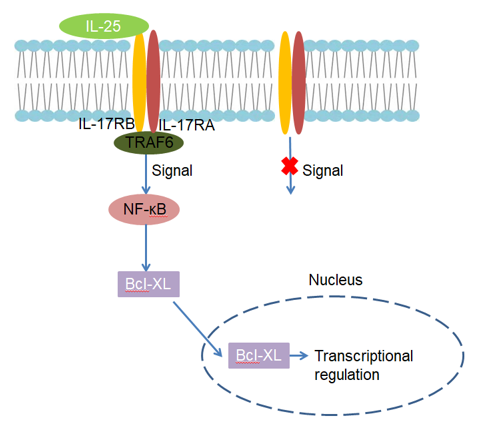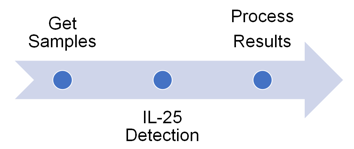Introduction
Interleukin 25 (IL-25), also known as IL-17E, is a newly discovered member of the IL-17 cytokine family, but is only 16% homologous to IL-17A in amino acid sequence. IL-25 is mainly derived from mast cells, eosinophils and basophils stimulated by stem cell factors. In addition, intestinal epithelial cells and brain microvascular endothelial cells can also secrete IL-25. IL-25 can induce the differentiation of non-T cells, non-B cells, and hematopoietic stem cells (C-kit), thereby initiating an immune response and expelling intestinal parasites. IL-25 can characteristically induce eosinophil infiltration, activate Th2 cell response, and up-regulate the expression level of IL-4, IL-5, IL-13 and other cytokines. The production of these cytokines is also related to increase of serum IgE, IgGl, IgA level and the infiltration of eosinophils in various tissues.
Mechanism and Function
IL-25 is mainly secreted by bone marrow stromal cells, which can promote the proliferation of lymphoid lineages, but has no effect on myeloid cells. The human IL-25 gene is located at 14q11.2, a total of 3987bp, contains an open reading frame of 483bp, encoding 161 amino acids, and its products are a hydrophobic signal peptide composed of 16 amino acids and a mature protein composed of 145 amino acids. There are two alternative spliced mRNAs encoding two different subtypes. The mRNAs of both subtypes contain 2 exons, and subtype 2 has a shorter N-terminus than subtype 1. Subtype 1 mRNA encodes a protein consisting of 177 amino acids, and subtype 2 mRNA encodes a protein consisting of 161 amino acids. Both subtypes have an identical C-terminus consisting of 159 amino acids.
The biological activity of IL-25 is regulated by the transmembrane transport receptor IL-25R (also called IL-17RB). It is a single 56kD transmembrane protein, and its intracellular and extracellular regions are relatively conserved Cysteine sequence structure, whose gene is fixed at 3p21 of human chromosome, and has homology with IL-17R. Human IL-25R is highly expressed in T cells of kidney, liver and intestine, especially Th2 memory cells. In addition, cells in peripheral blood and mucosa can express IL-25R highly. IL-25 and IL-17RB combine to play a biological role, but in fact the receptor of IL-25 should be a heterodimer composed of IL-17RA and IL-17RB. Although IL-25 does not bind to IL-17RA, IL-17RA gene knockout cannot effectively stimulate the production of IL-5 and IL-13, indicating that both IL-17RA and IL-17RB are involved in IL-25 signaling. After IL-25 is combined with IL-25R, it can activate NF-κB to transmit signals by interacting with TRAF6.
IL-25 can directly inhibit the expression of IL-23 induced by lipopolysaccharide and can reduce the inflammatory cytokine response driven by Toll-like receptor ligands in human blood monocytes and intestinal CD14+ cells. In addition, IL-25 can also prevent and treat experimental enteritis in mice mediated by Th1 cell response driven by intestinal bacteria by inhibiting the production of Th1-related factors. In addition, the injection of IL-25 in vivo can significantly improve the symptoms of experimental autoimmune encephalomyelitis and rheumatoid arthritis. The study also found that IL-25 has an anti-tumor effect. In various human tumor xenograft models, IL-25 injection every other day showed significant anti-tumor activity.
 Fig 1. Mechanism of Signaling
Fig 1. Mechanism of Signaling
Creative Proteomics can provide cytokine detection platform for scientific research. According to different purposes, our dedicated analysts will customize exclusive solutions for you. We aim to provide customers with high-quality and convenient services to help you accelerate the progress of your project.
Our cytokine detection service includes but is not limited to:
- One or more cytokines qualitative and quantitative detection
- Cytokines qualitative and quantitative detection of various species
- Cytokine antibodies qualitative and quantitative detection
Sample requirements
- Sample Types- Serum, plasma, cell supernatant, urine, body fluids, lavage fluid, cerebral spinal cord, atrial water, pleural water, tissue, etc.
- Sample Volume - It is optimal for 50 samples. This volume allows for triplicate testing of each sample.
Our advantages:
- Different detection methods can be selected based on different samples and requirements.
- Ensure the specificity and accuracy of the test by using high quality antibodies.
- Repeat the test to ensure the repeatability and accuracy of the experimental results.
- Feedback results are accurate and efficient.
Technology platform:
We mainly provide the Luminex cytokine detection platform. Luminex uses fluorescently encoded microspheres with specific antibodies to different target molecules. The different microspheres can be combined freely to a certain extent so that up to 100 analytes can be tested multiple times simultaneously in a single experiment.
The Luminex cytokine assay platform has the following advantages:
- Multiple detection: simultaneous detection of 100 biological targets
- Short experiment time: 1-3 weeks
- High sensitivity: the lower limit of accurate quantification is as low as 0.1 pg/mL
- Save samples: only need a sample volume as low as 25 μL
- Time saving: the experiment process only takes 4 hours
For your different needs, we can also provide the following detection methods:
- Enzyme-linked immunosorbent assay (ELISA)
- Flow cytometry
Workflow

For more information about the IL-25 detection service or need other detection requirements, please contact us.
References:
- Kim MR, et al. Transgenic overexpression of human IL-17E results in eosinophilia, B-lymphocyte hyperplasia, and altered antibody production. Blood, 2002, 100: 2330-2340.
- Buning C, et al. The interleukin-25 gene located in the inflammatory bowel disease (IBD) 4 region: no association with inflammatory bowel disease. European J Immunogenetics, 2003, 30: 329-333.



